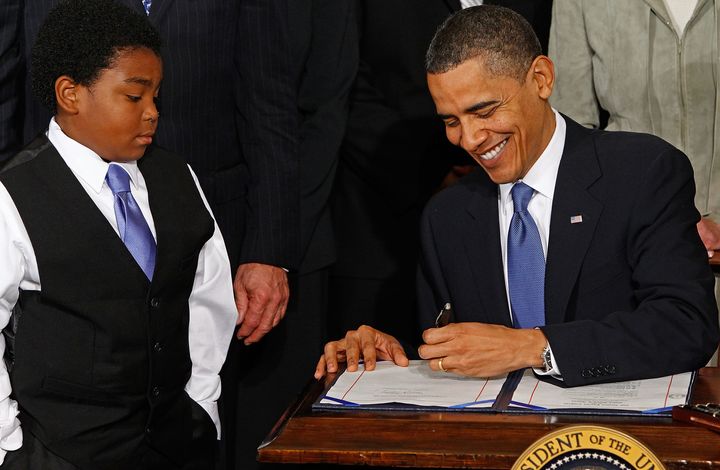The White House attempted to discredit the non-partisan Congressional Budget Office on Wednesday, releasing a video that questions the accuracy of the agency’s previous projections on health insurance coverage under Obamacare.
Issued as a heated health care debate continues on Capitol Hill, the administration seems to be arguing that because CBO estimates have been off before, there is no reason to trust its recent reports predicting that a Republican-led effort to repeal the Affordable Care Act would have devastating effects.
But just 10 seconds into the video, the White House instead managed to strain its credibility with a misspelling of the word “inaccurately.”
A short time later, the White House Twitter account deleted the video and re-posted a version with the spelling corrected.
The mistake fits a well-documented trend of the administration’s communications team stepping on its own message with embarrassing typos and other blunders and miscues.
But the White House doesn’t just need a copy editor. It needs a better argument, too.
Republicans ― both in President Donald Trump’s administration and Congress ― have been challenging the CBO’s credibility ever since it first produced estimates showing that Obamacare repeal legislation would mean no insurance for 20 or even 30 million people, depending on the specific bill. CBO’s estimates of the Senate GOP bill, which the chamber’s leaders introduced last month, suggested the number of people without insurance would rise by 22 million.
That number has helped to alienate the public ― and it has spooked Republican senators at a time when GOP leaders are a few votes short of the 50 they need to pass a bill. And so the White House, which wants that vote badly, has resumed its campaign against the CBO, using a variety of disingenuous arguments.
On the most important number, the overall number of people with and without health insurance under Obamacare, CBO was not far off. When the ACA first became law, CBO predicted that, by 2016, the percent of non-elderly Americans without coverage would fall to 7.6 percent. That was before the Supreme Court made the law’s expansion of Medicaid optional ― a decision that nobody (not even the lawsuit’s supporters) expected.
If you adjust for the effects of that decision, as the Center on Budget and Policy Priorities did recently, the initial CBO projection for 2016 becomes 9.4 percent. The actual 2016 rate, according to the Centers for Disease Control and Prevention’s National Health Insurance Study (NHIS), was 10.4 percent.
The CBO and NHIS figures aren’t precisely the same, because everybody who studies the uninsured uses slightly different methods and baselines. But comparisons to other surveys yields basically the same result: CBO didn’t miss by much.

The biggest error in CBO calculations was enrollment in ACA health care exchanges, which has fallen far below projections at 10.3 million. That’s the figure Republicans keep citing and that’s in the White House video, which it says left the CBO projection “off by over 14 million.” But at least part of that error occurred because the CBO expected more employers to drop job-based coverage, leading people to seek coverage under Obamacare. But that didn’t happen ― which isn’t necessarily a bad thing.
The fact that CBO guessed wrong on employer behavior doesn’t make its error on exchange enrollment any smaller. But it’s a reminder that error can run in both directions ― and that, frequently, mistakes in the underlying projections about how insurance will change can offset one another. (Case in point: The program as a whole also appears to be costing the federal government less than anticipated ― which, again, isn’t a bad thing.)
None of this means CBO is perfect or that its predictions should be treated as gospel. Many conservatives think the CBO overestimates the impact of ending the individual mandate ― the requirement that people get insurance or pay a financial penalty to the government. They may be right. But CBO’s experts are smart, rigorous and scrupulous. (Don’t forget, the current director is a Republican appointee.) More important, its projections are as good as anybody’s ― and quite possibly better, as a 2015 Commonwealth Fund report showed.
Pretend for a moment CBO predictions about the Republican Senate bill are way, way off, and the actual effect on the uninsured rate would end up being just half what the agency’s economists believe ― 11 million fewer people with health care coverage. That’s still a lot! And it doesn’t even account for all the people who would pay more for their medical care because, under the GOP proposal, insurance would tend to have less comprehensive coverage and in some cases leave out key services.
The reality of the Senate bill is that, by design, it would drain a huge amount of money out of federal health programs. Some people would be better off. Young and healthy people might be happy with skimpier health plans, for the sake of the lower premiums that come with them. Very wealthy people would no longer pay the extra income taxes to finance Obamacare’s coverage expansion.
But many others would pay the price, because their insurance would cover less or they would simply have no coverage at all ― and the numbers of these people would, by all accounts, be in the tens of millions.
Beating up the CBO won’t change that. Even if the administration gets the spelling right the next time.